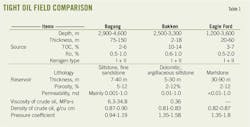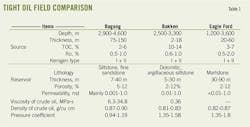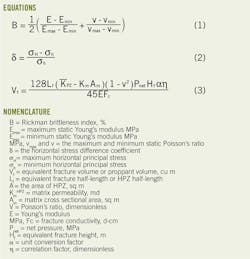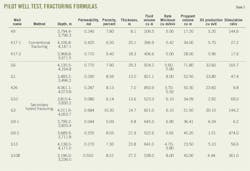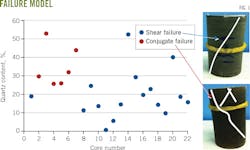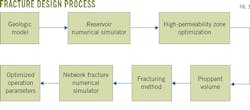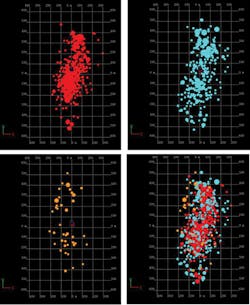Hybrid fracturing pilot increases China's Dagang tight oil production
Zhihong Zhao Songgen He Jianchun Guo
Southwest Petroleum University
Chengdu, China
Shengchuan Zhang
China National Petroleum Corp.
Tianjin,China
Hybrid fracturing used in combination with secondary fracturing boosted stimulated reservoir volume (SRV) and conductivity in a pilot on Dagang-field vertical oil wells in China's Bohai basin.
The combination of fracturing techniques helped producers unlock tight oil reservoirs more effectively than a single fracturing technique would have. Hybrid fracturing yields a complex fracture network by using slick water or linear gels and carries proppant into the fracture using cross-linked gel.
Tight oil reservoirs, usually involving clastics or carbonates, exist in plays where oil migrated from the source rock to a reservoir offering very low matrix-permeability (in-situ permeability ≤0.1 md).1 Similar to US plays, tight oil accounts for much of China's reserves. Table 1 compares the two nation's tight oil reservoirs.
Companies developing northeastern China's Dagang field, discovered and brought on stream in 1965, strive to more effectively produce tight oil using emerging completion and production technology to handle the main reservoir's high water cut.
Researchers applied secondary hybrid fracturing to eight wells. Different from conventional fracturing, secondary fracturing has two independent procedures. The first procedure is like conventional fracturing but the well also is shut in for about 1 hr to ensure proppant settlement.
The second fracturing procedure helps obtain complexity and conductivity. Well G1, with a vertical depth of 3,483-96 m and reservoir thickness of 13 m, showed the best results. Logging data demonstrated average permeability of 0.29 md, average porosity of 8.56%, and oil saturation of 48.1%.
Well G1 has 79.1% broad-brittle minerals and 33% quartz. Rickman's brittleness index showed 51% medium brittleness. G1's horizontal-stress difference coefficient was 0.2-0.3, higher than differential strain analysis results from other wells.
Based on optimal length of 160 m and equivalent average permeability of 6 md, optimal proppant volume was 52.5 cu m.
This secondary-hybrid fracturing pilot increased fracture complexity by using mostly low-viscosity linear gels in the first stage and a cross-linked gel in the second stage.
Stress interference reduced the horizontal-stress difference coefficient during first-stage hydraulic fracturing. A lower stress-difference coefficient also can increase fracture density and connectivity.
The use of numerical simulation helped optimize field test parameters for fractures (Table 2).
Fracability
Tubing-head pressure of the second stage was about 15 MPa lower than the first stage, likely because the first stage generated a complex multi-branch fracture. The second stage experienced a different failure mode.
Well G1 had a complex fracture network and higher fracture conductivity. Its oil production rate increased to a rounded 213 b/d from 4 b/d after fracturing with a stimulation ratio of 47.4.
Researchers expanded testing of the secondary hybrid fracturing method to another seven vertical wells (Table 3). The wells in which conventional cross-linked gel fracturing was used in only one stage had average production of 35 b/d.
The field test involved the second member of Paleogene Kongdian formation of Cangdong sag (Kong 2 member). Reservoir characteristics exhibited fine-grained facies sedimentation.2
The Kong 2 member shows four vertical sequences: Ek24, Ek23, Ek22, and Ek21 from bottom to top. Kong 2 features sedimentation created during maximum lake flooding in the Kongdian formation. Sedimentation consists of fine grey sandstone, grey mudstone, and red mudstone.
Tight oil comes from good shale having enough thickness, total organic carbon (TOC), and formation conductivity indicated by vitrinite reflectance, Ro, which demonstrates the thermal maturity of organic matter. But the low pore space, permeability, viscosity of crude oil, and pressure coefficient show the low-flow capacity of oil in reservoir rock.
Dagang field has higher oil viscosity and density than the Bakken formation in North Dakota or Eagle Ford shale in South Texas. Consequently, Dagang field, which has a deeper formation, requires more SRV than the Bakken or Eagle Ford plays.
Reservoir characteristics and engineering factors, including rock brittleness, stress difference, natural fracture, net pressure, and fracturing fluid viscosity, determine a formation's ability to generate a complex fracture network (fracability).
X-ray diffraction data show Kong 2 member has broad brittle minerals, including quartz, feldspar, and carbonate.
Kong 2's average Young's modulus was 18,047 MPa while the average Poisson's ratio was 0.322 during a triaxial compression test in which the confining pressure was 40 MPa. The average Rickman brittleness index was 42.3% using Equation 1 for the triaxial compression test.3
Both the mineral composition and mechanics parameters reflected the reservoir's medium brittleness. Triaxial compression test results involved two categories: shear failure and conjugate failure. Conjugate failure was more prone with increased quartz content (Fig.1).
Shear failure accounted for most failures while conjugate failure was limited. Results demonstrated the difficulty of generating complex fracture networks in the Kong 2 member given its mineral components.
The differential strain analysis shown in Table 4 yielded Kong 2's in situ stresses. The horizontal principal stress gradient is 1.41-1.71 MPa/100 m and the horizontal stress difference coefficient 0.1-0.2 (Equation 2).
Natural fracture widths, shown in core samples in Fig. 2, typically measured 0.03-0.23 mm.
The Kong 2 member demonstrated primarily horizontal bedding and middle-low angle natural fractures. Natural fracture conditions proved favorable for generating a fracture network, but maintaining conductivity under high vertical stress in those fractures proved difficult.
The brittleness index, the stress difference, and natural fracture were moderately favorable. The Kong 2 member provides medium fracability and development potential using an appropriate combination of fracturing techniques.
Conductivity
Researchers used massive hydraulic fracturing to connect natural fractures across a large area and increase SRV.
Two failure types resulted from this process: tensile fracture and shear fracture. High-concentration proppant was needed to achieve conductivity when the rock faces aligned in tensile fractures.
Resulting displacement yielded conductivity and also provided self-support within the shear fractures. Conductivity of proppant-supported aligned fractures was tested based on API standards. Smooth rock plates were made from cores of the Kong 2 member, as outlined by API standards.
A broken-gel fracturing fluid carried ceramic proppant. Researchers studied proppant embedding and fluid damage effects by injecting broken gel into the cell for 2 hr at 0.5 MPa before the test.
With increased size and proppant concentration, conductivity increases were obvious at closure pressures lower than 40 MPa. Conductivity only increased slightly when closure pressure was higher than 40 MPa. The fracture can achieve conductivity of about 5 darcies-cm (d∙cm) under 50-MPa closure pressure.
Self-supported displaced fracture sensitivity was tested by following API conductivity standards. Testers used Kong 2 member plates and a rock splitter.
Cutting the opposite sides of the top- and bottom-fractured cores yielded displacement of 2.54 mm. Plates were mounted in a conductivity cell without proppant. Test fluid was water with 2% fracturing fluid. The self-support displaced fracture started with conductivity of 13.6 d∙cm, which declined quickly to 0.01 d∙cm at 34.5-MPa closure pressure.
Higher closure pressures produced conductivity values beyond the minimum test limit. The in situ stress of the Kong 2 member was more than 44.4 MPa, so conductivity of self-support displaced fractures was very low.
The fracturing design model for Kong 2 did not test for self-support displaced fractures. An appropriate proppant concentration designed for the specific fracture network enabled better crude oil flow.
Fracturing design
Fig. 3 shows the basic workflow of the fracturing design process for tight oil reservoirs. The fracture networks (or SRV) were simplified as a high-permeability zone (HPZ) according to the equivalent seepage principle.4
Calculating a ratio of the HPZ width and length yielded a fracture complexity index. Index calculation used fracability evaluations or microseimic data.
HPZ parameters included area and equivalent average permeability. Parameters were tested for optimized productivity simulation. Kong 2 member's optimal length was 160 m and equivalent average permeability was 6 md.
Equation 3 calculates the required proppant volume based on fracture conductivity and optimal HPZ parameters.
Conductivity of the self-support displaced fractures proved very low. Researchers selected proppant-support aligned fracturing as the primary approach to maintain fracture conductivity.
Based on the optimal HPZ parameters, fracability, and conductivity, a combination of secondary and hybrid fracturing was the best fracturing formula to boost tight oil production from the Kong 2 member.
Hybrid fracturing involves creating complex fractures using slick water or linear gels and then carrying proppant into the fractures with cross-linked gel.5
Typically, hybrid fracturing yields a more complex fracture network than cross-linked gel fracturing alone. Gel enhances proppant placement better than water. Researchers found hybrid fracturing was necessary to balance effective fracture length and equivalent average permeability (or conductivity) for the Kong 2 member.
But for middle-fracability vertical wells, hybrid fracturing's complexity was still insufficient, prompting use of secondary hybrid fracturing. Secondary fracturing was divided into two fracturing stages with a shut-in interval to obtain enough complexity and conductivity.
Fig. 4 shows seismic results at three stages of fracturing with two shut-in intervals in a vertical well on a tight-gas block. The main fracture network was generated mainly in Stage 1. The SRV (or HPZ) increased slowly, and density and connectivity improved, during Stage 2.
Secondary fracturing proved best for Stage 3, with secondary hybrid fracturing best for the Kong 2 member. Considering proppant volume and secondary hybrid fracturing, crews targeted optimal HPZ parameters using a fracture numerical simulator.
Dagang tight oil wells completed in a pilot using a combination of fracturing techniques had higher production rate increases, averaging 99 b/d, and the process boosted the stimulation ratio to 150.4 from 63.1.
Acknowledgment
The authors would like to thank the Youth Science Foundation of the National Natural Science Foundation of China (51504204) for its support.
References
1. Clarkson, C. R. and Pedersen, P. K., "Production analysis of Western Canadian unconventional light oil plays," Canadian Unconventional Resources Conference, Calgary, Nov. 15-17, 2011.
2. Pu, X., Zhou, L., Han, W., Zhou, J., Wang, W., Zhang, W., Chen, S., Shi, Z., and Liu, S., "Geologic features of fine-grained facies sedimentation and tight oil exploration: A case from the Second Member of Paleogene Kongdian Formation of Cangdong sag, Bohai Bay basin," Petroleum Exploration and Development, Vol. 43, No. 1, February 2016, pp. 26-35.
3. Rickman R., Mullen M. J., Petre J.E., Grieser W. V., and Kundert D., "A practical use of shale petrophysics for stimulation design optimization: All shale plays are not clones of the Barnett shale," Society of Petroleum Engineers Annual Technical Conference and Exhibition, Denver, Sept. 21-24, 2008.
4. Zeng, J., Deng, Y., Guo, J., Lu, C., Gou, B., and Zeng, F., "A Mathematical model for calculating the volume of proppant in shale vertical wells," Society of Petroleum Engineers/ Ikatan Ahli Teknik Perminyakan Indonesia (SPE-IATPI) Asia Pacific Oil & Gas Conference and Exhibition, Nusa Dua, Bali, Oct. 20-22, 2015.
5. Sharma, M. M., Gadde, P. B., Sullivan, R., Sigal, R., Fielder, R., Copeland, D., Griffin, L., and Weijers, L., "Slickwater and hybrid fracs in the Bossier: Some Lessons Learned," SPE Annual Technical Conference and Exhibition, Houston, Sept. 26-29, 2004.
The authors
Zhihong Zhao ([email protected]) lectures at the School of Petroleum and Gas Engineering, Southwest Petroleum University, Chengdu, China. He obtained his PhD (2011) in petroleum engineering from Southwest Petroleum University.
Songgen He ([email protected]) is a doctoral student in reservoir stimulation theory and technology at State Key Laboratory of Oil and Gas Reservoir Geology and Exploitation at Southwest Petroleum University. He obtained his BS in petroleum engineering (2011) and his MS in petroleum engineering (2014) from Southwest Petroleum University.
Jianchun Guo ([email protected]) is a professor and dean of the School of Petroleum and Gas Engineering, Southwest Petroleum University. He obtained his PhD (1998) in petroleum engineering from Southwest Petroleum University. He is a Society of Petroleum Engineers member.
Shengchuan Zhang ([email protected]) is deputy chief engineer of Petroleum Engineering Institute of Dagang Oil Field, CNPC. He obtained his MS (2001) in petroleum engineering from China University of Petroleum,Beijing.
